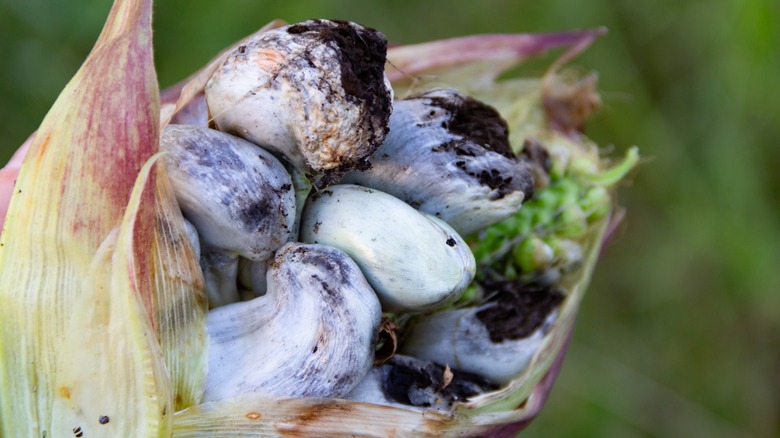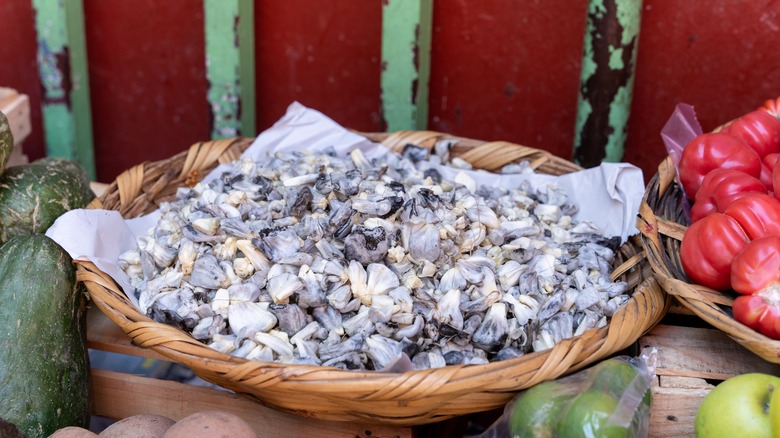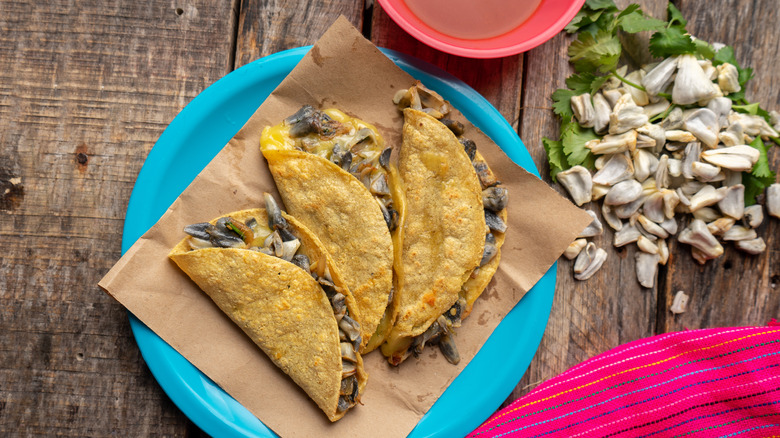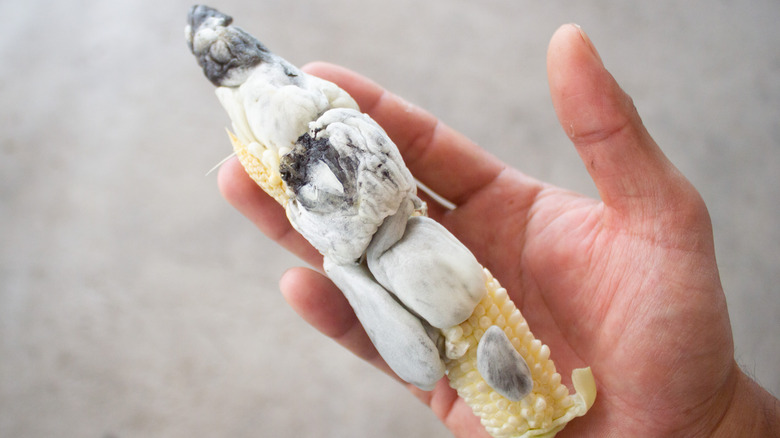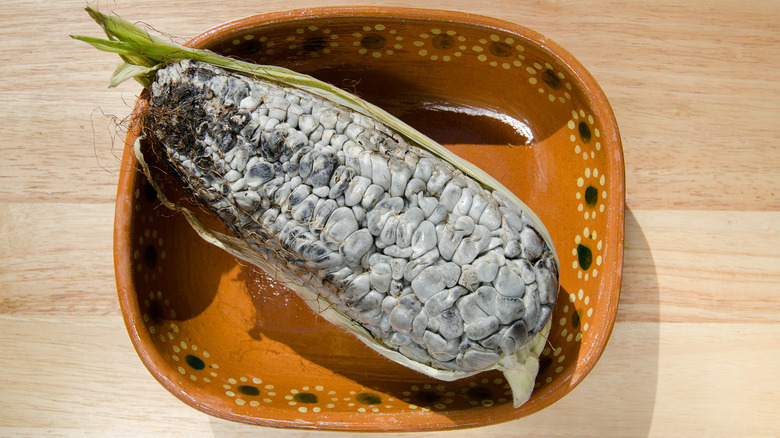Why Mexico's Huitlacoche Corn Fungus Is Prized By Chefs
Mexican gastronomy dazzles — there's nothing quite like the country's delectable dishes. And it's not only about the recipe; everything from agricultural practices, cooking techniques, and regional ingredients led to the cuisine's induction into UNESCO's list of Intangible Cultural Heritage. The underlying core of the cuisine is corn, first domesticated in Mexico 7,000 years ago. Today, 80% of Mexico's corn is used to make tortillas, per Discover Baja. Nixtamalization, a process invented by the Aztecs to increase corn's nutrient bioavailability, made the farming of corn a central component of the civilization via Experience Mayahuel.
The crop is susceptible to droughts, floods, or parasitic issues, and its destruction is usually problematic. However, there is a specific infection that's an exception — and continues to be celebrated for its presence. Meet huitlacoche, a delicious corn fungus packed with flavor. Experiencing a new resurgence, the food is once again prized, and it's easy to see why (per Atlas Obscura). Let's dive into what it's all about.
What is huitlacoche?
Huitlacoche, scientifically known as ustilago maydis, is a fungus that grows on the ears of corn during rainy seasons. Ranging in color from a light gray to a black-bluish tint, the infection consumes corn kernels and forms a cloud-like growth outside the plant. Its soft and chewy consistency makes it a pleasant textural component. The taste also entices, with a savory flavor reminiscent of other mushrooms, combined with smoky and earthy undertones, according to Fine Dining Lovers.
Huitlacoche is a seasonal fungus, gathered only over a brief period of time. Such elusiveness makes the food considered a treat– esteemed by Michelin chefs, street vendors, and home cooks. Although readily found in Mexico, huitlacoche is yet to take off in the U.S. and is only grown by a handful of farmers. However, the ingredient is wonderfully versatile, used in sauces and omelets, as well as a filling for quesadillas, tacos, and more, notes Eater.
How to cook with huitlacoche
Huitlacoche can be consumed raw, although it's usually cooked. The fungus is used like other mushrooms — sauteed whole, cut into pieces, or pureed. It pairs well with cheese, making it a common ingredient in quesadillas, but it also works as a filling for tacos and tamales. Huitlacoche seamlessly integrates into a range of sauces, adding a delectable earthy flavor, explains Food Republic. Sauteeing huitlacoche with garlic, tomatoes, chilies, and onion is a common aromatic starting point. The ingredient further melds well with other components, such as epazote, peppers, and especially masa, notes Masterclass.
Huitlacoche quesadillas are a widespread street food in South and Central Mexico — the perfect dish for first culinary applications. Combine huitlacoche with chorizo, or simply pair it with a fatty cheese, via Travel Food Atlas. Alternatively, eat the fungus raw, especially when blessed with a fresh, white variety, an excellent addition to salads, per Texcoco. It's hard to go wrong when cooking with the plant — particularly when fortunate enough to find it fresh.
How to find and select huitlacoche
Huitlacoche used to have a negative reputation with American farmers, as it was seen as an infective threat to corn. Yet attitudes are changing, backed by its excellent flavor and protein-rich nutrition. Purveyors are popping up in the U.S., with the sale of the flavorful fungus worth seeking out. Keep in mind the huitlacoche starts out white when fresh and progressively darkens the longer it's kept. Its best fresh, with canning not flattering to its taste and texture, explains Texas Monthly.
Most huitlacoche in the U.S. is sold frozen, which is a slightly better preservation method than canning. Like with other mushrooms, it's even possible to forage for the food, although keep in mind the fungus only appears in organic corn fields, notes Forager Chef. In Mexico, especially in Central and Southern regions, huitlacoche is easily found in markets and grocery stores. It's often sold by weight, per M.A. kitchen.
How to store huitlacoche
Huitlacoche is highly perishable — lasting only up to 10 days in the refrigerator. Like other mushrooms, avoid storing in plastic, with the inclusion of the growth's original cob as the best storage method. If flash frozen, the fungus will keep for a year, per Cornell University. When lucky with excess fungus, dehydration is another viable option. Simply soak the fungus in water before adding it to a dish, notes Forager Chef.
If frequently using huitlacoche, reach for a food dehydrator. Humidity is problematic to the fungus, so cleaning and sealing in the kernels can greatly extend its fridge life. Just avoid eating huitlacoche that's excessively damp or has a rotten smell — at this point, the bountiful fungus has already perished, explains Keep and Store. After purchasing a bundle, it's unlikely you'll need to store much of it anyways. With a rich, earthy flavor, the ingredient is sought for a good reason — there's simply nothing else like it.
